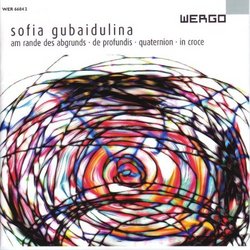| All Artists: Sofia Gubaidulina Title: Gubaidulina: Am Rande des Abgrunds; De Profundis; Quaternion; In croce Members Wishing: 3 Total Copies: 0 Label: Wergo Germany Original Release Date: 1/1/2006 Re-Release Date: 12/12/2006 Album Type: Import Genre: Classical Styles: Chamber Music, Historical Periods, Classical (c.1770-1830), Instruments, Strings Number of Discs: 1 SwapaCD Credits: 1 UPC: 4010228668421 |
Search - Sofia Gubaidulina :: Gubaidulina: Am Rande des Abgrunds; De Profundis; Quaternion; In croce
 | Sofia Gubaidulina Gubaidulina: Am Rande des Abgrunds; De Profundis; Quaternion; In croce Genre: Classical
|
Larger Image |
CD Details |
CD ReviewsA very minor Gubaidulina disc, where most of the pieces can Christopher Culver | 11/05/2008 (3 out of 5 stars) "This Wergo disc, released in 2006, features pieces by Sofia Gubaidulina representing a wide range of her mature career. Soloists here include
Julius Berger on cello and Stefan Hussong on accordion. The most recent work on this disc is "On the Edge of the Abyss" for seven cellos and two waterphones (2002). The title of the work refers to the gap between the cello strings and the fingerboard, where a pure tone can become noise if the strings are pressed too far. As one might expect, the work is full of extended techniques like Bartok pizzicatos. The formal scheme is readily apparent. It begins with a couple of minutes of introduction where the cello players enter and are all on the same page musically. The main movement has more heterogenous cello parts, and then the waterphones enter with their weird science-fiction sounds, all sparkling glissandi. Finally, there's a coda that recapitulates to some degree the introduction. All in all, I find this word interesting, but far too light for pleasure. It seems like a mere sketch of something much vaster. "On the Edge of the Abyss" is the only world premiere recording here. The other pieces have all been recorded before, a couple multiple times, and I fail to see the need for yet another go at them here when so many great Gubaidulina pieces ("Zeitgestalten", "The Lyre of Orpheus", the Russian-language "St. John Easter") are not yet available in commercial recording. In "Quaternion" for four cellos (1996), Gubaidulina attempts to create a contrast of light versus dark by having two cellos tuned a quarter tone lower than the other two. Musically no new ground is broken here, as Per Norgard and Gyorgy Ligeti were experimenting with such tuning at the end of the 1970s, but nonetheless the dramatic elements of the piece make it pretty entertaining. Still, I favour the performance on a Chandos disc with cellist Alexander Ivashkin and others. "In Croce" (1982), originally for cello and organ and here heard in its arrangement for cello and bayan, is one of Gubaidulia's early mature masterpieces. It is an exploration of "vertical" music (the organ or bayan) intersected by the "horizontal" (cello), thus forming the cruciform symbolism so common in Gubaidulina's work. But you'd be better off hearing this on a Naxos disc where the accordionist Elsbeth Moser, a friend of Gubaidulina's and arranger of this version of the work, performs. And personally, I prefer the performance of the cello and organ version by Ivashkin and Hicks on that same Chandos disc as "Quaternion", for the organ just seems to work better than the bayan. "De Profundis" for bayan (1978) starts with rumbling bass chords separated by profound silences, and then climbs to the highest range of the instrument and then producing every kind of sound possible with the instrument. This solo work work provides the most overt virtuosity of any of the pieces here and is very moving. Still, you could hear it performed just as well by Geir Draugsvoll on a BIS disc. All in all, this strikes me as a very minor release, best for Gubaidulina completists who want "On the Edge of the Abyss"." |

 Track Listings (4) - Disc #1
Track Listings (4) - Disc #1